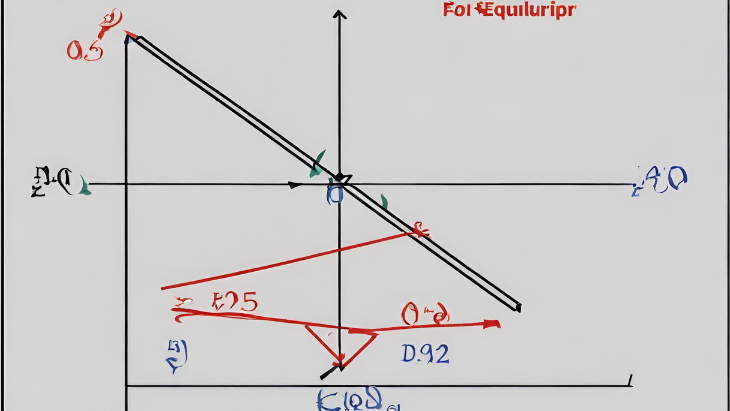In a free market, the equilibrium price is the price at which the quantity demanded of a good or service is equal to the quantity supplied. This is the price at which the forces of supply and demand are in balance.
Equilibrium Price
In economics, the equilibrium price is the price at which the quantity demanded of a good or service is equal to the quantity supplied. This is the price at which the forces of supply and demand are in balance.
The equilibrium price can be found by setting the demand curve equal to the supply curve. This can be done algebraically or graphically.
Algebraically, the equilibrium price can be found by solving the equation:
Qd = Qs
Where:
- Qd is the quantity demanded
- Qs is the quantity supplied
Graphically, the equilibrium price can be found by finding the point where the demand curve and the supply curve intersect.
The equilibrium price is an important concept in economics. It is used to determine the price of goods and services in a free market.
Here are some additional details about equilibrium price:
- The equilibrium price is determined by the interaction of supply and demand.
- The demand curve shows the quantity of a good or service that consumers are willing to buy at a given price.
- The supply curve shows the quantity of a good or service that producers are willing to sell at a given price.
- When the demand curve intersects the supply curve, the market is in equilibrium.
- At the equilibrium price, there is neither a shortage nor a surplus of the good or service.
Conclusion
The equilibrium price is a fundamental concept in economics. It is used to determine the price of goods and services in a free market. By understanding how the equilibrium price is determined, we can better understand how markets work.
Additional Information
In addition to the above, here are some additional things to keep in mind about equilibrium price:
- The equilibrium price can change if the demand curve or the supply curve shifts.
- A shift in the demand curve can be caused by changes in consumer preferences, income, or the price of related goods or services.
- A shift in the supply curve can be caused by changes in production costs, technology, or the availability of inputs.
Conclusion
Equilibrium price is a dynamic concept that can change over time. By understanding the factors that can cause the equilibrium price to change, we can better understand how markets respond to change.
Demand Curve
In economics, a demand curve is a graph that shows the relationship between the price of a good or service and the quantity of that good or service that consumers are willing to buy. The demand curve is typically downward-sloping, which means that consumers are willing to buy more of a good or service at a lower price.
The demand curve is determined by the law of demand, which states that consumers will buy less of a good or service as the price of that good or service increases. There are a number of factors that can affect the demand curve, including:
- Consumer income: As consumer income increases, consumers are typically willing to buy more of most goods and services.
- Price of related goods and services: If the price of a substitute good or service decreases, consumers are typically willing to buy less of the original good or service.
- Consumer preferences: Consumers’ preferences for a particular good or service can change over time, which can affect the demand curve.
- Expected future prices: If consumers expect the price of a good or service to increase in the future, they may be willing to buy more of that good or service today.
The demand curve is an important concept in economics. It is used to predict how consumers will respond to changes in price, income, and other factors.
Here are some additional details about the demand curve:
- The demand curve is typically downward-sloping because of the law of demand.
- The demand curve is drawn with price on the vertical axis and quantity demanded on the horizontal axis.
- The demand curve is a graphical representation of the demand schedule.
- The demand curve can be used to predict how consumers will respond to changes in price.
Conclusion
The demand curve is a fundamental concept in economics. It is used to predict how consumers will respond to changes in price, income, and other factors. By understanding the demand curve, we can better understand how markets work.
Supply Curve
In economics, a supply curve is a graph that shows the relationship between the price of a good or service and the quantity of that good or service that producers are willing to supply. The supply curve is typically upward-sloping, which means that producers are willing to supply more of a good or service at a higher price.
The supply curve is determined by the law of supply, which states that producers will be willing to supply more of a good or service as the price of that good or service increases. There are a number of factors that can affect the supply curve, including:
- Production costs: As production costs increase, producers are typically willing to supply less of a good or service.
- Technology: Technological advances can lead to increased production and supply.
- Government regulation: Government regulations can affect the supply of goods and services.
- Expectations of future prices: If producers expect the price of a good or service to increase in the future, they may be willing to supply less of that good or service today.
The supply curve is an important concept in economics. It is used to predict how producers will respond to changes in price, production costs, and other factors.
Here are some additional details about the supply curve:
- The supply curve is typically upward-sloping because of the law of supply.
- The supply curve is drawn with price on the vertical axis and quantity supplied on the horizontal axis.
- The supply curve is a graphical representation of the supply schedule.
- The supply curve can be used to predict how producers will respond to changes in price.
Conclusion
The supply curve is a fundamental concept in economics. It is used to predict how producers will respond to changes in price, production costs, and other factors. By understanding the supply curve, we can better understand how markets work.
Supply and Demand Analysis
In economics, supply and demand analysis is a method used to predict the price and quantity of a good or service in a market. This analysis is based on the law of supply and demand, which states that the price of a good or service is determined by the interaction of supply and demand.
Supply is the quantity of a good or service that producers are willing to sell at a given price. Demand is the quantity of a good or service that consumers are willing to buy at a given price.
The equilibrium price is the price at which the quantity supplied is equal to the quantity demanded. At the equilibrium price, there is no shortage or surplus of the good or service.
Supply and demand analysis can be used to predict how changes in supply or demand will affect the price and quantity of a good or service. For example, if the supply of a good or service decreases, the price of that good or service will typically increase. If the demand for a good or service increases, the price of that good or service will typically increase.
Here are some of the key concepts of supply and demand analysis:
- Law of supply: Producers are willing to supply more of a good or service at a higher price.
- Law of demand: Consumers are willing to buy more of a good or service at a lower price.
- Equilibrium price: The price at which the quantity supplied is equal to the quantity demanded.
Supply and demand analysis is a fundamental concept in economics. It is used to predict how markets work and to make decisions about pricing, production, and investment.
Here are some additional details about supply and demand analysis:
- Supply and demand curves can be used to visualize the relationship between supply and demand. The supply curve is typically upward-sloping, while the demand curve is typically downward-sloping.
- The equilibrium price can be found by setting the supply curve equal to the demand curve. This can be done algebraically or graphically.
- Changes in supply or demand can cause the equilibrium price to change. A shift in the supply curve can be caused by changes in production costs, technology, or the availability of inputs. A shift in the demand curve can be caused by changes in consumer preferences, income, or the price of related goods or services.
Conclusion
Supply and demand analysis is a powerful tool that can be used to understand how markets work. By understanding the concepts of supply and demand, businesses and individuals can make better decisions about pricing, production, and investment.
Pricing
In business, pricing is the process of setting the price for a good or service. Pricing is a critical decision for businesses, as it can affect profitability, market share, and customer satisfaction.
There are a number of factors that businesses need to consider when setting prices, including:
- Cost: The cost of producing or providing the good or service.
- Demand: The amount of consumers who are willing to buy the good or service at a given price.
- Competition: The prices of similar goods or services offered by competitors.
- Company goals: The company’s overall goals, such as profitability, market share, or customer satisfaction.
There are a number of pricing strategies that businesses can use, including:
- Cost-plus pricing: Setting a price that is equal to the cost of producing or providing the good or service plus a profit margin.
- Market-based pricing: Setting a price that is based on the prices of similar goods or services offered by competitors.
- Value-based pricing: Setting a price that is based on the perceived value of the good or service to consumers.
Pricing is a complex and challenging process. There is no one-size-fits-all approach to pricing, and businesses need to carefully consider their specific circumstances when setting prices.
Here are some additional details about pricing:
- Pricing is a critical decision for businesses, as it can affect profitability, market share, and customer satisfaction.
- There are a number of factors that businesses need to consider when setting prices, including cost, demand, competition, and company goals.
- There are a number of pricing strategies that businesses can use, including cost-plus pricing, market-based pricing, and value-based pricing.
Conclusion
Pricing is a critical decision for businesses. By understanding the factors that affect pricing and by using the right pricing strategy, businesses can set prices that are profitable and that help them achieve their goals.











